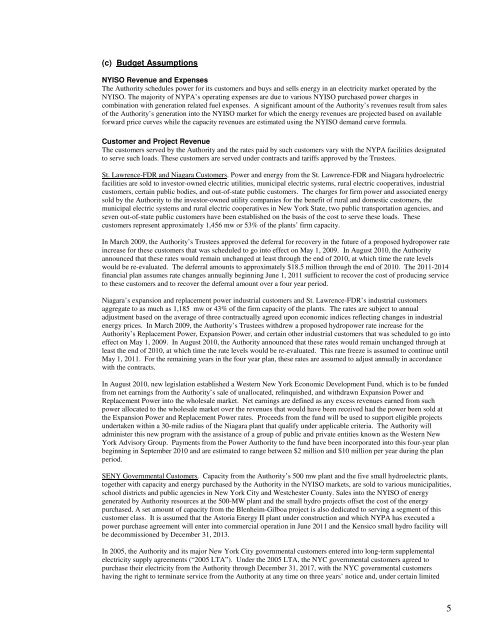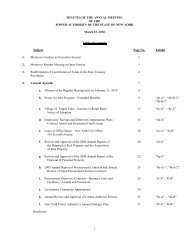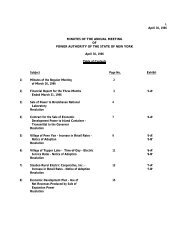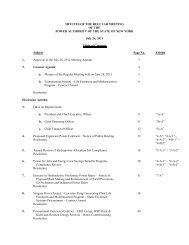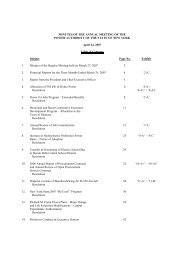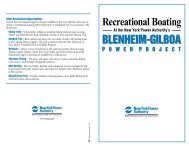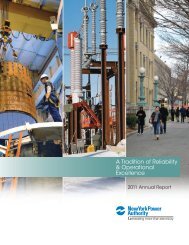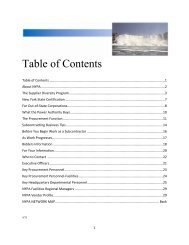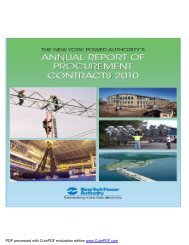PDF - New York Power Authority
PDF - New York Power Authority
PDF - New York Power Authority
Create successful ePaper yourself
Turn your PDF publications into a flip-book with our unique Google optimized e-Paper software.
(c) Budget Assumptions<br />
NYISO Revenue and Expenses<br />
The <strong>Authority</strong> schedules power for its customers and buys and sells energy in an electricity market operated by the<br />
NYISO. The majority of NYPA’s operating expenses are due to various NYISO purchased power charges in<br />
combination with generation related fuel expenses. A significant amount of the <strong>Authority</strong>’s revenues result from sales<br />
of the <strong>Authority</strong>’s generation into the NYISO market for which the energy revenues are projected based on available<br />
forward price curves while the capacity revenues are estimated using the NYISO demand curve formula.<br />
Customer and Project Revenue<br />
The customers served by the <strong>Authority</strong> and the rates paid by such customers vary with the NYPA facilities designated<br />
to serve such loads. These customers are served under contracts and tariffs approved by the Trustees.<br />
St. Lawrence-FDR and Niagara Customers. <strong>Power</strong> and energy from the St. Lawrence-FDR and Niagara hydroelectric<br />
facilities are sold to investor-owned electric utilities, municipal electric systems, rural electric cooperatives, industrial<br />
customers, certain public bodies, and out-of-state public customers. The charges for firm power and associated energy<br />
sold by the <strong>Authority</strong> to the investor-owned utility companies for the benefit of rural and domestic customers, the<br />
municipal electric systems and rural electric cooperatives in <strong>New</strong> <strong>York</strong> State, two public transportation agencies, and<br />
seven out-of-state public customers have been established on the basis of the cost to serve these loads. These<br />
customers represent approximately 1,456 mw or 53% of the plants’ firm capacity.<br />
In March 2009, the <strong>Authority</strong>’s Trustees approved the deferral for recovery in the future of a proposed hydropower rate<br />
increase for these customers that was scheduled to go into effect on May 1, 2009. In August 2010, the <strong>Authority</strong><br />
announced that these rates would remain unchanged at least through the end of 2010, at which time the rate levels<br />
would be re-evaluated. The deferral amounts to approximately $18.5 million through the end of 2010. The 2011-2014<br />
financial plan assumes rate changes annually beginning June 1, 2011 sufficient to recover the cost of producing service<br />
to these customers and to recover the deferral amount over a four year period.<br />
Niagara’s expansion and replacement power industrial customers and St. Lawrence-FDR’s industrial customers<br />
aggregate to as much as 1,185 mw or 43% of the firm capacity of the plants. The rates are subject to annual<br />
adjustment based on the average of three contractually agreed upon economic indices reflecting changes in industrial<br />
energy prices. In March 2009, the <strong>Authority</strong>’s Trustees withdrew a proposed hydropower rate increase for the<br />
<strong>Authority</strong>’s Replacement <strong>Power</strong>, Expansion <strong>Power</strong>, and certain other industrial customers that was scheduled to go into<br />
effect on May 1, 2009. In August 2010, the <strong>Authority</strong> announced that these rates would remain unchanged through at<br />
least the end of 2010, at which time the rate levels would be re-evaluated. This rate freeze is assumed to continue until<br />
May 1, 2011. For the remaining years in the four year plan, these rates are assumed to adjust annually in accordance<br />
with the contracts.<br />
In August 2010, new legislation established a Western <strong>New</strong> <strong>York</strong> Economic Development Fund, which is to be funded<br />
from net earnings from the <strong>Authority</strong>’s sale of unallocated, relinquished, and withdrawn Expansion <strong>Power</strong> and<br />
Replacement <strong>Power</strong> into the wholesale market. Net earnings are defined as any excess revenues earned from such<br />
power allocated to the wholesale market over the revenues that would have been received had the power been sold at<br />
the Expansion <strong>Power</strong> and Replacement <strong>Power</strong> rates. Proceeds from the fund will be used to support eligible projects<br />
undertaken within a 30-mile radius of the Niagara plant that qualify under applicable criteria. The <strong>Authority</strong> will<br />
administer this new program with the assistance of a group of public and private entities known as the Western <strong>New</strong><br />
<strong>York</strong> Advisory Group. Payments from the <strong>Power</strong> <strong>Authority</strong> to the fund have been incorporated into this four-year plan<br />
beginning in September 2010 and are estimated to range between $2 million and $10 million per year during the plan<br />
period.<br />
SENY Governmental Customers. Capacity from the <strong>Authority</strong>’s 500 mw plant and the five small hydroelectric plants,<br />
together with capacity and energy purchased by the <strong>Authority</strong> in the NYISO markets, are sold to various municipalities,<br />
school districts and public agencies in <strong>New</strong> <strong>York</strong> City and Westchester County. Sales into the NYISO of energy<br />
generated by <strong>Authority</strong> resources at the 500-MW plant and the small hydro projects offset the cost of the energy<br />
purchased. A set amount of capacity from the Blenheim-Gilboa project is also dedicated to serving a segment of this<br />
customer class. It is assumed that the Astoria Energy II plant under construction and which NYPA has executed a<br />
power purchase agreement will enter into commercial operation in June 2011 and the Kensico small hydro facility will<br />
be decommissioned by December 31, 2013.<br />
In 2005, the <strong>Authority</strong> and its major <strong>New</strong> <strong>York</strong> City governmental customers entered into long-term supplemental<br />
electricity supply agreements (“2005 LTA”). Under the 2005 LTA, the NYC governmental customers agreed to<br />
purchase their electricity from the <strong>Authority</strong> through December 31, 2017, with the NYC governmental customers<br />
having the right to terminate service from the <strong>Authority</strong> at any time on three years’ notice and, under certain limited<br />
5


